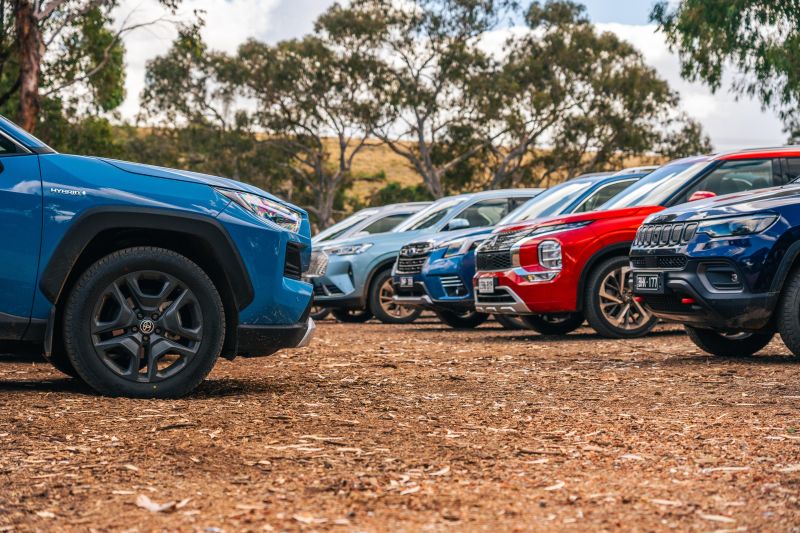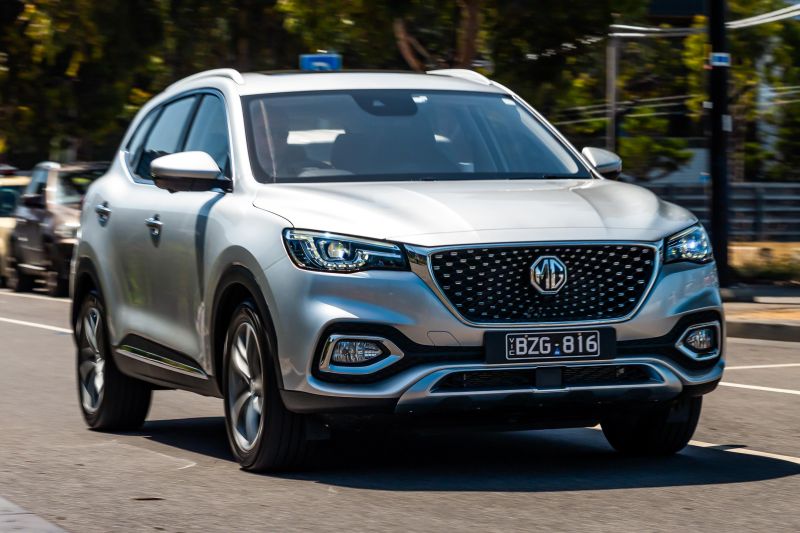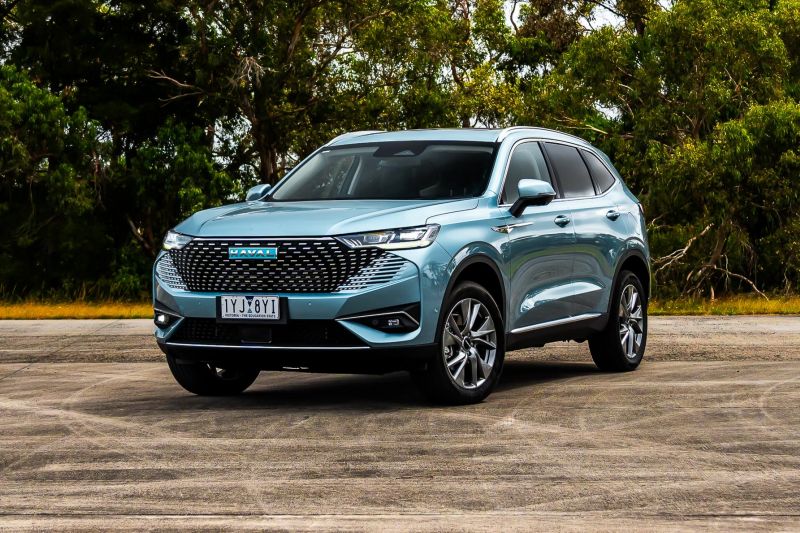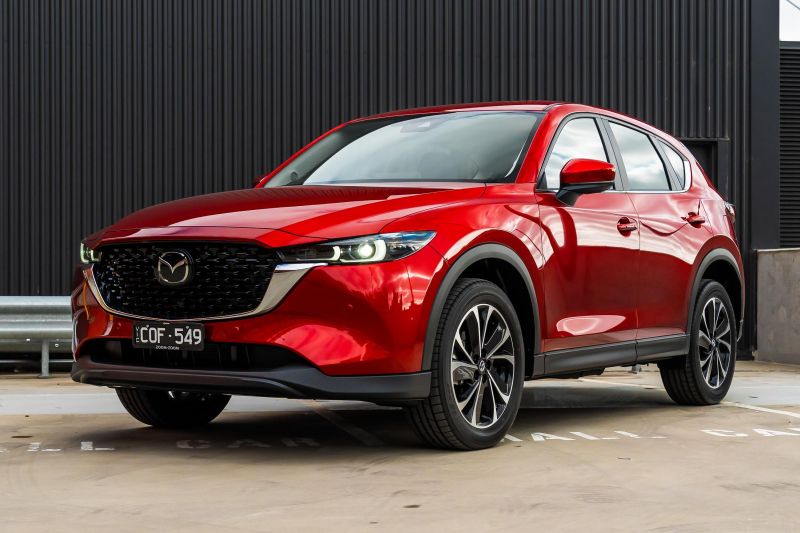Size often comes at the cost of efficiency in the SUV world, but some medium SUVs straddle the middle ground and provide the best of both worlds.
After narrowing the pool to medium SUVs that retain an internal combustion engine, how do they rank for efficiency?
We’ve gathered the data, using claimed combined fuel economy figures provided by manufacturers, to find out.
These are the cars within the medium SUV under $60k category in the VFACTS sales charts published by the Federal Chamber of Automotive Industries (FCAI).
We’ve also measured based on the variant with the best fuel economy in the range, as some trim or powertrain options may see the figures quoted here increase slightly.
Mitsubishi Outlander
The Mitsubishi Outlander Plug-in Hybrid EV (PHEV) takes top spot on this list with a claimed average fuel consumption figure of 1.5L/100km.
While petrol versions start at $37,740 before on-road costs, more efficient PHEV variants can’t be had for less than $57,290 plus on-roads.
Outlander PHEV models are powered by a plug-in hybrid powertrain consisting of a 2.4-litre four-cylinder petrol engine, twin electric motors and a 20.0kWh lithium-ion battery pack, producing total system outputs of 185kW of power and 450Nm of torque.
If you want to avoid refuelling stops completely, the Outlander PHEV has a claimed pure electric driving range of 84km according to NEDC testing.
All versions are backed by Mitsubishi’s conditional 10-year warranty.
| Mitsubishi Outlander | |
|---|---|
| Fuel economy (claimed) | 1.5L/100km |
| Fuel tank capacity | 56L |
| Fuel type | 91 RON |
BUY: Get in touch with a dealer about a Mitsubishi Outlander
MORE: Everything Mitsubishi Outlander
Peugeot 3008
Like Mitsubishi, Peugeot offers the 3008 in both petrol and plug-in hybrid forms, with the latter sitting as the most efficient model in the lineup.
The 3008 GT Sport PHEV is among the most expensive cars in this segment at $82,915 before on-road costs, over $32,000 more than the base model.
In addition to a hybrid powertrain, the flagship gains all-wheel drive. Standard equipment includes a 12.3-inch digital instrument cluster, 10.0-inch touchscreen infotainment system, 19-inch alloy wheels and Nappa leather interior trim.
WLTP testing has returned an electric range figure of 59km for the 3008 PHEV.
| Peugeot 3008 | |
|---|---|
| Fuel economy (claimed) | 1.6L/100km |
| Fuel tank capacity | 43L |
| Fuel type | 95 RON |
BUY: Get in touch with a dealer about a Peugeot 3008
MORE: Everything Peugeot 3008
MG HS
The MG HS is another member of the petrol-sipping PHEV club, with claimed fuel consumption of 1.7L/100km.
It’s also one of the cheapest plug-in hybrids available, priced from $48,990 drive-away.
Power comes from a 90kW/230Nm electric drive motor fed by by a 16.6kWh lithium-ion battery, paired with a 1.5-litre turbocharged four-cylinder petrol engine. Total system outputs are 189kW of power and 370Nm of torque.
Those wanting to travel fuel free can utilise 63km of pure electric range, which may come in handy as the HS requires 95 octane premium unleaded fuel.
| MG HS | |
|---|---|
| Fuel economy (claimed) | 1.7L/100km |
| Fuel tank capacity | 37L |
| Fuel type | 95 RON |
BUY: Get in touch with a dealer about a MG HS
MORE: Everything MG HS
Cupra Formentor
Cupra is known as a performance brand, but electrification is ensuring that new models are also efficient, which is exemplified by the Formentor VZe.
The price hike from petrol Formentor models to the PHEV is not as big a jump as other alternatives here – the VZe is available for $64,990 before on-road costs, $13,000 more than the base car.
Power is derived from the combination of a 1.4-litre turbocharged four-cylinder petrol engine, an electric motor with 85kW and 330Nm, and a lithium-ion battery with 12.8kWh capacity.
Total system outputs are 180kW and 400Nm.
Electric range is a claimed 58km, while the TSI engine requires premium unleaded petrol.
| Cupra Formentor | |
|---|---|
| Fuel economy (claimed) | 1.9L/100km |
| Fuel tank capacity | 40L |
| Fuel type | 95 RON |
BUY: Get in touch with a dealer about a Cupra Formentor
MORE: Everything Cupra Formentor
Toyota RAV4
The RAV4 is a mainstay in this segment and while no PHEV option is available in Australia, Toyota’s hybrid is the most efficient of any closed-circuit hybrid system in this segment.
Several hybrid variants are available, but the GX 2WD Hybrid achieves the best fuel economy with a claimed consumption figure of 4.7L/100km.
That particular version will set you back $42,260 before on-road costs, and is equipped with an 8.0-inch touchscreen infotainment system, 7.0-inch digital instrument cluster and 17-inch alloy wheels.
The RAV4 is backed by Toyota’s five-year, unlimited-kilometre warranty.
| Toyota RAV4 | |
|---|---|
| Fuel economy (claimed) | 4.7L/100km |
| Fuel tank capacity | 55L |
| Fuel type | 91 RON |
BUY: Get in touch with a dealer about a Toyota RAV4
MORE: Everything Toyota RAV4
Kia Sportage
Another closed-circuit hybrid option is the Kia Sportage HEV, which starts at $45,950 before on-road costs.
The HEV is powered by a 1.6-litre turbocharged four-cylinder engine paired with an electric motor for total system outputs of 169kW of power and 350Nm of torque, sent through the front wheels.
Two trim levels are available with the hybrid powertrain, but even the base SX receives a 12.3-inch touchscreen infotainment system, 4.2-inch digital instrument cluster and 18-inch alloy wheels.
Kia covers its lineup with a seven-year, unlimited-kilometre new car warranty.
| Kia Sportage | |
|---|---|
| Fuel economy (claimed) | 4.9L/100km |
| Fuel tank capacity | 52L |
| Fuel type | 91 RON |
BUY: Get in touch with a dealer about a Kia Sportage
MORE: Everything Kia Sportage
Honda ZR-V
The 2024 Honda ZR-V starts from $40,200 drive-away, but buyers in the market for an efficient hybrid powertrain will have to stretch to $54,900 drive-away for the top spec e:HEV LX.
You can think of the ZR-V as the middle child in Honda’s SUV range, sitting between the HR-V and CR-V in terms of size and price. It also presents with unique styling.
The flagship e:HEV LX may command top dollar within the range but it comes with all the kit, headlined by a wireless phone charger, heated rear seats and a heated steering wheel.
| Honda ZR-V | |
|---|---|
| Fuel economy (claimed) | 5.0L/100km |
| Fuel tank capacity | 57L |
| Fuel type | 91 RON |
BUY: Get in touch with a dealer about a Honda ZR-V
MORE: Everything Honda ZR-V
GWM Haval H6
The GWM Haval H6 is one of the budget options in this segment, with a starting price of $33,990 drive-away.
That will buy you a turbocharged petrol example, but the more frugal hybrid comes in at $42,990 drive-away. The HEV is front-wheel drive only, and has a system output of 179kW and 530Nm.
Aside from sharp pricing, another advantage this Chinese SUV has over its competitors is a 600L boot, which is larger than most rivals in this segment.
Even base hybrid variants are equipped with a 10.25-inch touchscreen infotainment system, 10.25-inch digital instrument cluster and heated front seats.
| Haval H6 | |
|---|---|
| Fuel economy (claimed) | 5.2L/100km |
| Fuel tank capacity | 61L |
| Fuel type | 91 RON |
BUY: Get in touch with a dealer about a GWM Haval H6
MORE: Everything GWM Haval H6
Honda CR-V
As with the ZR-V, the hybrid Honda CR-V sits at the very top of its range, commanding a $59,900 drive-away price tag.
That’s one of the more expensive closed-circuit hybrids in this segment, and this version of the CR-V only seats five.
The CR-V e:HEV RS is powered by a 2.0-litre naturally aspirated four-cylinder petrol engine mated with two electric motors, for total system outputs of 135kW of power and 335Nm of torque.
As well as hybrid power, the flagship e:HEV RS is set apart from other CR-Vs by its black exterior accents and red contrast stitching throughout the interior.
| Honda CR-V | |
|---|---|
| Fuel economy (claimed) | 5.5L/100km |
| Fuel tank capacity | 57L |
| Fuel type | 91 RON |
BUY: Get in touch with a dealer about a Honda CR-V
MORE: Everything Honda CR-V
Citroen C5 Aircross
The Citroen C5 Aircross is a rare sight on Australian roads, with just 41 sold in 2023.
Sharing a powerplant with the Peugeot 5008, the C5 Aircross makes identical power and torque outputs, but is smaller in stature with seating for five people only.
With that said, boot space still measures 580L, and you’ll pay nearly $11,000 less for the Citroen.
Standard features include a panoramic sunroof, 10.0-inch touchscreen infotainment system, 12.3-inch digital instrument cluster and wireless phone charging.
| Citroen C5 AirCross | |
|---|---|
| Fuel economy (claimed) | 5.7L/100km |
| Fuel tank capacity | 53L |
| Fuel type | 95 RON |
BUY: Get in touch with a dealer about a Citroen C5 Aircross
MORE: Everything Citroen C5 Aircross
Nissan X-Trail
Nissan sold 12,861 X-Trails last year, and buyers remain spoilt for choice when it came to variants.
Four trim levels are available, and the X-Trail can be had with front- or all-wheel drive, with five or seven seats, and with naturally aspirated or hybrid four-cylinder powertrains.
Hybrid e-Power versions are the most efficient choice, consuming 6.1L/100km.
The cheapest electric-assisted variant is the five-seat ST-L e-Power with a sticker price of $49,990 plus on-road costs, while the range maxes out with the Ti-L e-Power ($57,690 before on-road costs).
All hybrid powered examples require a minimum of 95 RON premium unleaded fuel.
| Nissan X-Trail | |
|---|---|
| Fuel economy (claimed) | 6.1L/100km |
| Fuel tank capacity | 55L |
| Fuel type | 95 RON |
BUY: Get in touch with a dealer about a Nissan X-Trail
MORE: Everything Nissan X-Trail
Hyundai Tucson
You won’t find any hybrid options within the Hyundai Tucson range… yet
Instead, the Korean manufacturer has stuck with diesel power for its medium SUV, opting for a 2.0-litre four-cylinder turbo-diesel engine which produces 137kW and 416Nm.
With that said, the 2025 Tucson is set to ditch diesel for hybrid propulsion, so you’ll have to grab one of these quick.
Pricing for the turbo-diesel starts at $46,650 before on-road costs, which in Elite trim brings 18-inch alloy wheels, a 10.25-inch touchscreen infotainment system with satellite navigation, heated front seats and a 10-way power driver’s seat.
| Hyundai Tucson | |
|---|---|
| Fuel economy (claimed) | 6.3L/100km |
| Fuel tank capacity | 54L |
| Fuel type | Diesel |
BUY: Get in touch with a dealer about a Hyundai Tucson
MORE: Everything Hyundai Tucson
Skoda Karoq
All Skoda Karoq variants have a good old fashioned petrol engine under the bonnet, consuming 6.5L/100km in 1.4-litre turbocharged four-cylinder guise.
Considering the efficiency on offer, the Karoq’s 50L fuel tank is on the smaller side.
Three versions are available, but the base model sets the bar for efficiency, and is priced at $39,990 drive-away.
Without ticking any options boxes you get a 8.0-inch touchscreen infotainment system, 8.0-inch digital instrument cluster, wireless smartphone mirroring and 18-inch alloy wheels.
| Skoda Karoq | |
|---|---|
| Fuel economy (claimed) | 6.5L/100km |
| Fuel tank capacity | 50L |
| Fuel type | 95 RON |
BUY: Get in touch with a dealer about a Skoda Karoq
MORE: Everything Skoda Karoq
Subaru Forester
A new generation of Subaru Forester is on the way, but until then the most frugal model available is the Hybrid which is capable of 6.7L/100km on the combined cycle.
Hybrid variants are powered by a 2.0-litre four-cylinder engine producing 100kW and 196Nm, mated with an electric motor producing 12kW and 66Nm and a lithium-ion battery pack. As you’d expect, the Forester comes with all-wheel drive.
Hybrid pricing kicks off at $44,090 before on-road costs, and tops out at just over $50,000 plus on-roads.
Over the base models, the hybrid gains heated front seats as well as front and side cameras.
| Subaru Forester | |
|---|---|
| Fuel economy (claimed) | 6.7L/100km |
| Fuel tank capacity | 48L |
| Fuel type | 91 RON |
BUY: Get in touch with a dealer about a Subaru Forester
MORE: Everything Subaru Forester
Mazda CX-5
Mazda sold 23,083 examples of the CX-5 in 2023, coming in behind only the Toyota RAV4 and Mitsubishi Outlander for sales volume.
All models utilise petrol power in 2024, the most efficient being the G20 Maxx front-wheel drive base model.
Priced at $36,950 plus on-road costs, the G20 Maxx FWD is powered by a 2.0-litre naturally aspirated four cylinder engine that makes 115kW and 200Nm.
Standard features include a 10.25-inch infotainment system, wireless smartphone mirroring, and a 7.0-inch digital instrument cluster.
| Mazda CX-5 | |
|---|---|
| Fuel economy (claimed) | 6.9L/100km |
| Fuel tank capacity | 56L |
| Fuel type | 91 RON |
BUY: Get in touch with a dealer about a Mazda CX-5
MORE: Everything Mazda CX-5
Chery Tiggo 7 Pro
The Chery Tiggo 7 Pro can be had for between $39,990 and $45,990 drive-away.
All variants consume between 7-8L/100km courtesy of a 1.6-litre turbocharged four-cylinder engine producing 137kW of power and 275Nm of torque.
While the front-wheel drive models are more efficient, all-wheel drive examples have a 6L bigger fuel tank.
One area where the Tiggo 7 has no peers is boot space – 626L with the seats up is class-leading.
| Chery Tiggo 7 Pro | |
|---|---|
| Fuel economy (claimed) | 7.0L/100km |
| Fuel tank capacity | 51L |
| Fuel type | 95 RON |
BUY: Get in touch with a dealer about a Chery Tiggo 7 Pro
MORE: Everything Chery Tiggo 7 Pro
GWM Haval H6 GT
Compared to the regular H6 Hybrid, the H6 GT prioritises style over efficiency.
Two-wheel drive models consume 7.5L/100km, while that number balloons to 8.4L/100km for four-wheel drive variants.
Power is sourced from a 2.0-litre turbocharged four-cylinder petrol engine producing 150kW of power and 320Nm of torque.
The GT is a more expensive proposition that the regular H6, priced between $40,990 and $46,490 drive-away.
| Haval H6 GT | |
|---|---|
| Fuel economy (claimed) | 7.5L/100km |
| Fuel tank capacity | 61L |
| Fuel type | 91 RON |
BUY: Get in touch with a dealer about a Haval H6 GT
MORE: Everything Haval H6 GT
SsangYong Korando
A few factors are going against the SsangYong Korando in the efficiency stakes.
The headline figure is 7.7L/100km, which places the Korando in the bottom three, while 95 RON premium unleaded fuel is required as a minimum when filling up.
At 47L, the fuel tank is also the smallest of the cars on this list without the assistance of an electric motor.
Korando pricing kicks off at $28,990 plus on-road costs, making it the cheapest car in the segment, and the only to come in at under $30,000.
| SsangYong Korando | |
|---|---|
| Fuel economy (claimed) | 7.7L/100km |
| Fuel tank capacity | 47L |
| Fuel type | 95 RON |
BUY: Get in touch with a dealer about a SsangYong Korando
MORE: Everything SsangYong Korando
Volkswagen Tiguan
The Volkswagen Tiguan also consumes 7.7L/100km, although it has a 58L fuel tank.
Several variants are available including the performance-focused Tiguan R, but the base 110TSI models are the pick of the bunch in terms of efficiency.
Powered by a 1.4-litre turbocharged four-cylinder petrol engine producing 110kW of power and 250Nm of torque, the 110 TSI Life is priced at $43,990 before on-road costs.
The Life comes standard with a 8.0-inch touchscreen infotainment system, a 10.25-inch digital instrument cluster, wireless smartphone mirroring and 18-inch alloy wheels.
| Volkswagen Tiguan | |
|---|---|
| Fuel economy (claimed) | 7.7L/100km |
| Fuel tank capacity | 58L |
| Fuel type | 95 RON |
BUY: Get in touch with a dealer about a Volkswagen Tiguan
MORE: Everything Volkswagen Tiguan
Renault Koleos
The Renault Koleos rounds out this list with a claimed average fuel consumption of 8.1L/100km.
That figure is achieved by front-wheel drive variants, which kick off at $37,500 before on-road costs.
Under the bonnet is a 2.5-litre naturally aspirated four-cylinder engine making 126kW and 226Nm.
Unlike many modern SUVs, the Koleos come standard with a full-size spare wheel.
| Renault Koleos | |
|---|---|
| Fuel economy (claimed) | 8.1L/100km |
| Fuel tank capacity | 60L |
| Fuel type | 91 RON |
BUY: Get in touch with a dealer about a Renault Koleos
MORE: Everything Renault Koleos























